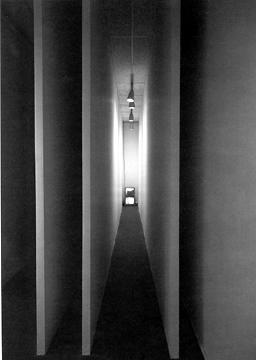Instantaneity
The most obvious departure the video image makes from its cinematic cousin is that it can be instantly available: recording and broadcasting can be simultaneous, and this technological possibility has offered a wide variety of uses from broadcast television to remote sensing, from the proliferation of security and surveillance cameras in the urban environment to various artistic experiments.
I’ll take Dan Graham as a useful point of departure to discuss the latter, not because he was unique—many artists undertook similar explorations in the 1970s—but because he can serve to index this trajectory. I’ll begin by reading a piece from Graham’s book Video-Architecture-Television. He writes:
Video is a present-time medium. Its image can be simultaneous with its perception by/of its audience (it can be an image of its audience perceiving). The space/time it presents is continuous, unbroken and congruent to that of the real time which is the shared time of its perceivers… This is unlike film which is, necessarily, an edited representation of the past of another reality… for separate contemplation by unconnected individuals. Film is discontinuous, its language constructed, in fact, from syntactical and temporal disjunctions (for example, montage). Film is a reflection of a reality external to the spectator’s body; the spectator’s body is out of frame. In a live video situation, the spectator may be included in frame at one moment or be out of frame at another moment. Film constructs a “reality” separate and incongruent to the viewing situation; video feeds back indigenous data in the immediate, present-time environment or connects parallel time-space continua. Film is contemplative and “distanced”; it detaches a viewer from present reality and makes him [sic] a spectator. (Graham, p. 62)
Clearly what Graham is describing is a particular possibility rather than a necessary consequence of video technology. In his own work he used this possibility to undertake series of experiments into space, architecture, perception and memory. For instance, he constructed rooms which staged contrasts between direct perception, mirror reflections, live video and delayed video.
Describing the piece Present Continuous Past(s) (1974), Graham wrote:
The mirror reflects present time. The video camera tapes what is in front of it and the entire reflection of the opposite mirrored wall. The image seen by the camera (reflecting everything in the room) appears 8 seconds later in the video monitor.
This means that the camera will tape the reflected image of the monitor, setting up an infinite regress of time continuums (always separated by an eight second delay). Further:
The mirror at right-angles to the other mirror-wall and to the monitor wall gives a present time view of the installation as if observed from an objective vantage exterior to the viewer’s subjective experience… It simply reflects present time.
Graham also made a series of “time delay” rooms. In Time Delay Room 1 (1974), spectators in room A could see those in room B live on one monitor and on an eight second delay on the other, while those in room B could see audience A live and themselves on delay. Spectators could walk between the two rooms, which was timed to take about eight seconds. These time delay rooms constituted a series of quasi-psycho-sociological experiments in which Graham used live video as a tool to explore consciousness. His project is reminiscent of Dziga Vertov’s 1929 film The Man With The Movie Camera which used cinematic reflexivity to similar ends. Graham was particularly interested in the relationship of consciousness to philosophies of reflection and transparency. Interestingly, while his writings often seem to accept the equivalence of perception with self-presence, his experiments point elsewhere—to the continual implication of so-called “direct perception” with the deferred effects of memory. In this way, he cross-hatches phenomenology with a more psychoanalytic perspective. While I find his rooms fascinating, I must admit that I also find them rather unnerving—they seem too close to all those contemporary spaces dominated by surveillance cameras. (And, of course surveillance video footage is increasingly appearing as art in a gallery context.)
Graham’s idea of using video as part of a closed system or feedback loop was common to many artists—Gary Hill has been quoted as saying “Video’s intrinsic principle is feedback.” (Hill, 1993, p. 65) It fitted in nicely with the rise of systems theory and cybernetics being advanced by those such as Norbert Weiner at the time. It also marked a time when the idea of participatory art started to be channelled towards interactive art—a term which has been such a buzz word in the 1990s. In video works by artists such as Nam June Paik, the presence of the audience—whether as an image registered on a monitor, or as a sound event reproduced through an electronic feedback system—began to play an increasingly important role in providing the content and shaping the experience of the art work.
Paik also constructed some of the most hauntingly beautiful examples of video as feedback; for instance the various versions of his TV Buddha. Here the enigmatic relation between the immediacy of the live image and the materiality of the object is brought to a pitch. The Buddha, who sought to keep himself free from all external impressions by immersing himself in mystic contemplation, sits confronted by his own image. The resulting ambivalence in the status of both object and image reminds me of Maurice Blanchot’s suggestion that there are at least two interpretations of the imaginary, the realm of images. (Blanchot, 1982, 254-263) There is the ordinary interpretation, according to which the image follows the order of reality as its mirror or re-presentation. But there is also the path where the image points to the absent thing, not by a strategy of mastery but by evoking its presence as absence. What Blanchot underlines—and what Paik’s Buddha confirms—is that, in fact, there is no either/or choice between these two possibilities—faced with the image, we always experience an ambivalent mixture of presence and absence.
Essays – “Video Theory”.


